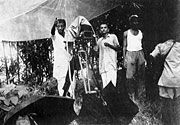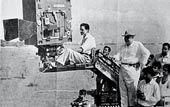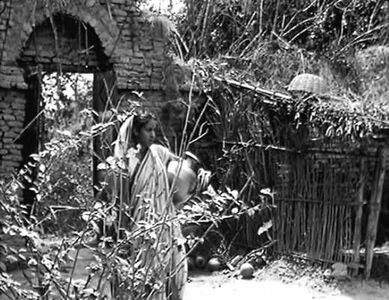I remember seeing Bansi Chandragupta, in my father’s library, resembling Sagina Mahato in the film by the same name. A half sleeved shirt worn over a dhoti with wide black strapped slippers, ruffled hair with a pocket full of papers with small notes. A man, who hardly spoke, bent over paintings of Raja Ravi Verma Oleographs and prints of Balthazar Solvyns. Both were know for their details. To the costumes, the environment, the objects. Bansi Chandragupta had an eye for details.
He would open large elephantine Oleographs of Raja Ravi Verma, on top of the divan in my father’s library and pour over them over hours. Sometimes with a magnifying glass. At other times just gaze at them.
Bansi Chandragupta, by far India's best art director and production designer, aspired to be a painter and came to Calcutta to study painting at the insistence of Subho Tagore. Bansi Chandragupta was born in 1924 in Sialkot, India, which is now part of Pakistan. He attended school in Kashmir and the, famous nephew of Rabindranath Tagore, Subho Tagore invited him to Calcutta. Bansi on arriving stayed with Subho Tagore at his Artist’s room in Metropolitan Building at Esplanade, which then housed the American Library commonly known as USIS.
Much of his time was spent in the American library where he poured over books on art. It is here that he met the famous film director Satyajit Ray in 1940s. It is well known that his friendship with Satyajit Ray attracted him to the career of art direction, then an unheard-of concept in Bengali or Indian cinema. Ardent and long viewing of Western films with Ray, mostly at the Calcutta Film Society (founded by Ray and his friend Chidananda Dasgupta, later a noted film critic), nurtured his imagination for realistic production sets, then lacking in most studio-oriented Indian films. It is Subho Tagore who brought him along to Kumars, where he found a treasure on Indian art- books, artifacts, paintings which he did not get an opportunity to inspect at the American Library.
It is well known that his first opportunity came in 1950, with Renoir's The River on the recommendation of Ray and Harisadhan Dasgupta. But the most satisfying beginning was the outdoor design sets for Ray's Pather Panchali, in 1954. Bansi Chandragupta created the hut in which Apu spends his childhood and other locales of the Bengali village to the last details, including the addition of one brick as a foot stone. His most accomplished work that marked him out in later life were studio sets for Ray's Charulata, Nayak, and Shatranj Ke Khilari. He designed the interior of a railway compartment for the shooting of Nayak ,so flawlessly that most viewers mistook it as a real. He recreated the mid-nineteenth century milieu of the British general Outram and the pre-mutiny Muslim habitats of Lucknow in Shatranj. His ambition to switch over to directing was cut short by his untimely death in 1981, though he made three documentaries for the West Bengal Government. Chandragupta's ideas on art direction and production design were very unconventional.
Although a pioneer and ardent advocate of location shooting, he told an interviewer later in life "outdoor shooting cannot compare with the excellence of indoor setting where factual details can be more easily established." For his most acclaimed work, in Shatranj, he was helped by the sketches of Gaziuddin Hyder in the collection of Kumars. The throne of Wajid Ali, for example, was re-created from one such painting.





